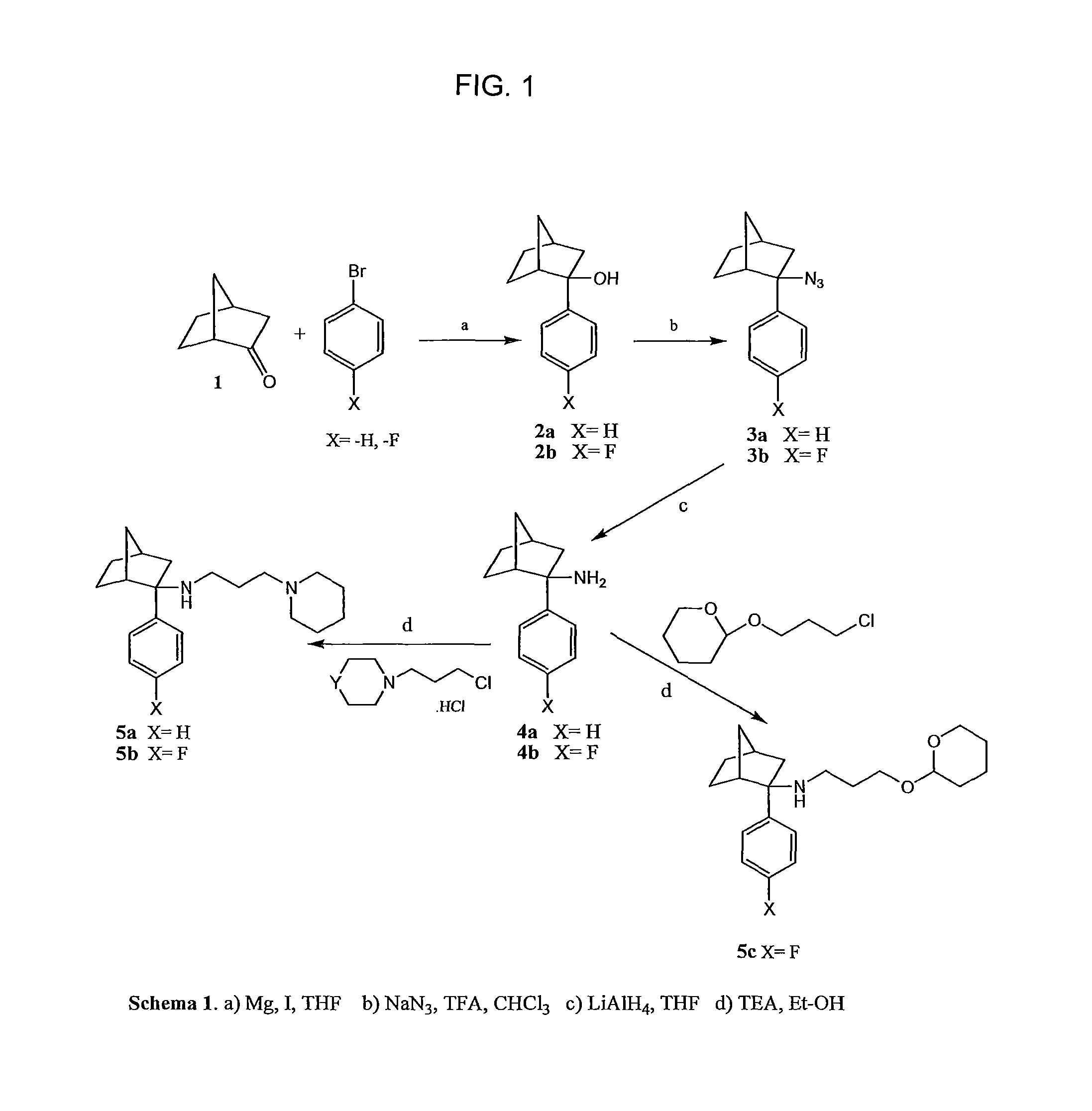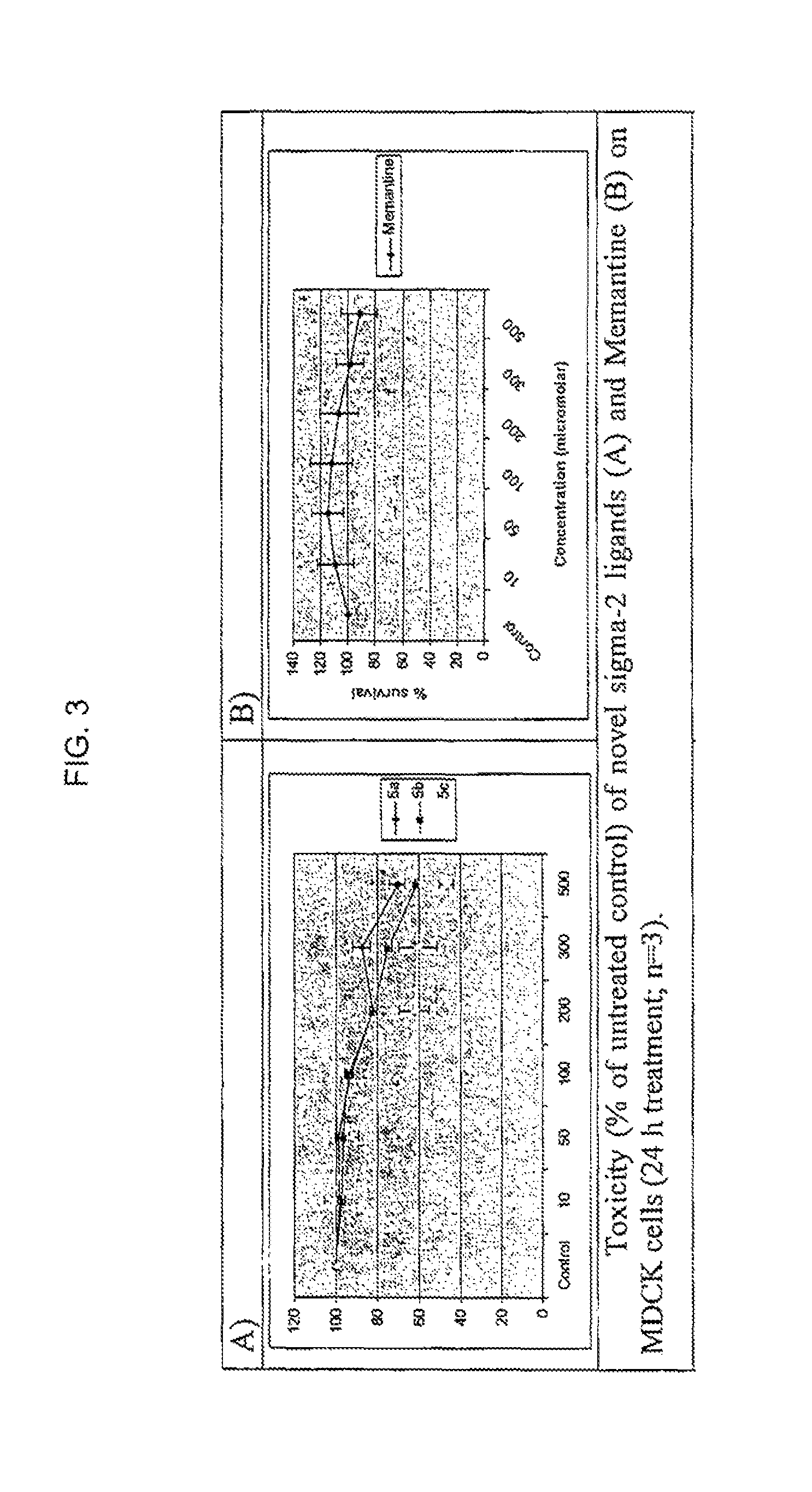Bicyclo-heptan-2-amines
a technology of bicycloheptan and heptane, which is applied in the field of bicycloheptane-2-amines, can solve the problems of inability to continue treatment, undesirable side effects, and cancer as the leading cause of death worldwid
- Summary
- Abstract
- Description
- Claims
- Application Information
AI Technical Summary
Benefits of technology
Problems solved by technology
Method used
Image
Examples
example 1
Materials and Methods
[0084]Melting points were determined with a MeI-Temp electrothermal apparatus and are uncorrected. The 1H, 13C and 19F NMR spectra were recorded with a 400 MHz Bruker NMR spectrophotometer with TMS as internal standard and CDCl3 as solvent. The Mass spectra were recorded with a Varian 1200 Triple Quadrupole instrument using electrospray ionization (ESI) technique. Column chromatography was conducted using Merck silica gel, grade 9385, 230-400 mesh, 60 Å. Compound purity was determined by elemental analysis conducted by Galbraith Laboratories, Knoxville, Tenn. The chemical reagents used in the synthesis were purchased from Aldrich, Acros and Alfa Aesar.
[0085]The synthetic route, shown in FIG. 1 (“Scheme 1”) was based in part on the method described in Geneste et al. (Geneste, P.; Herrmann, P.; Kamenka, J. M.; Pons, A.; New Synthesis of isomers of 1-phenylcyclohexylamines substituted on the cyclohexane ring. Bulletin De La Societe Chimique de France 1975, 1619-162...
example 2
Syntheses of compounds 2a-4-a
[0086]A mixture of bromobenzene (5.5 ml, 52.2 mmol), magnesium turnings (3.81 g, 157 mmol), and a few iodine crystals was stirred to give Grignard reagent and was added to norcamphor (5.75 g, 52.2 mmol) to give a crude alcohol as a red oil (2a, 9.2 g, 93% yield). Treatment of this alcohol (9.0 g, 47.8 mmol) with TFA (32 ml, 430 mmol) in the presence of sodium azide (9.3 g, 143 mmol) resulted in the tertiary azide as a red oil (3a, 9.3 g, 91% yield), This azide (9.3 g, 40 mmol) was reduced to the corresponding amine with LiAlH4 (2.5 g, 67 mmol) to give (±)-2-phenylbicyclo[2.2.1]heptan-2-amine (4a) as a clear oil (7.8 g, 90% yield). This oil (0.2 g) was purified by preparative TLC developed using a mixture of chloroform and diethyl ether (9:1, v / v) as mobile phase. A pale yellow oil was obtained, which solidified at 0° C. 1H NMR (CDCl3): δ ppm 7.3-7.4 (m, 5H), 1.0-2.6 (b, 10H, 4CH2 and 2CH). 13C NMR (CDCl3): δ 148.3, 128.6, 127.0, 126.4, 64.1, 48.5, 45.2, ...
example 3
Syntheses of Compounds 2b-4-b
[0087]Crude alcohol 2b (9.4 g, 99% yield) was obtained from p-bromofluorobenzene (5.00 ml, 45.5 mmol), magnesium turnings (3.32 g, 137 mmol), and norcamphor (5.00 g, 45.5 mmol) as described for synthesis of compound 2a. 1H NMR (CDCl3): δ ppm 7.63-7.43 (m, 2H), 7.15-6.96 (m, 2H), 2.58 (s, 1H), 2.44-2.11 (m, 3H), 1.81-1.26 (m, 7H); 13C NMR (CDCl3): δ ppm 162.8, 144.89, 127.7, 127.6, 114.9, 114.7, 80.45, 47.6, 46.9, 38.8, 37.6, 29.1, 22.28. Treatment of the alcohol (9.4 g, 46 mmol) with TFA (30.5 ml, 410 mmol) in the presence of sodium azide (8.89 g, 137 mmol) resulted in the tertiary azide as a red oil (3b, 10.5 g, 93.6% yield). The azide (10.5 g, 45.4 mmol) was then reduced to the corresponding amine with LiAlH4 (2.60 g, 68 mmol) to give (±)-2-(4-fluorophenyl)bicyclo[2.2.1]heptan-2-amine (4b) as a clear oil (6.6 g, 70.8% yield). The oil (0.4 g) was purified by preparative TLC developed using a mixture of chloroform and diethyl ether (9:1, v / v) as mobile p...
PUM
| Property | Measurement | Unit |
|---|---|---|
| molecular weight | aaaaa | aaaaa |
| temperature | aaaaa | aaaaa |
| length of time | aaaaa | aaaaa |
Abstract
Description
Claims
Application Information
 Login to View More
Login to View More - R&D
- Intellectual Property
- Life Sciences
- Materials
- Tech Scout
- Unparalleled Data Quality
- Higher Quality Content
- 60% Fewer Hallucinations
Browse by: Latest US Patents, China's latest patents, Technical Efficacy Thesaurus, Application Domain, Technology Topic, Popular Technical Reports.
© 2025 PatSnap. All rights reserved.Legal|Privacy policy|Modern Slavery Act Transparency Statement|Sitemap|About US| Contact US: help@patsnap.com



